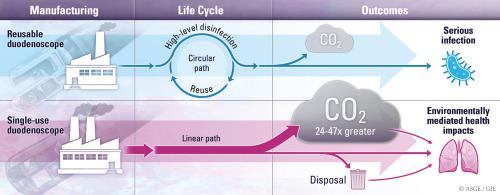Gastrointestinal Endoscopy ( IF 7.7 ) Pub Date : 2022-06-17 , DOI: 10.1016/j.gie.2022.06.014 Nguyen Nhat Thu Le 1 , Lyndon V Hernandez 2 , Nimish Vakil 3 , Nalini Guda 3 , Casey Patnode 1 , Olivier Jolliet 4

|
Background and Aims
The large-scale effects of duodenoscopes on the environment and public health have not been quantified. Our aim was to perform an exploratory life cycle assessment comparing environmental and human health effects of single-use duodenoscopes (SDs) and reusable duodenoscopes (RDs).
Methods
We evaluated 3 duodenoscopes: conventional RDs, RDs with disposable endcaps, and SDs. The primary outcomes were impacts on climate change and human health, complemented by multiple environmental impacts.
Results
Performing ERCP with SDs releases between 36.3 and 71.5 kg of CO2 equivalent, which is 24 to 47 times greater than using an RD (1.53 kg CO2) or an RD with disposable endcaps (1.54 kg CO2). Most of the impact of SDs comes from its manufacturing, which accounts for 91% to 96% of its greenhouse gas emission. The human health impact of RDs becomes comparable with the SD lower bound if disposable endcaps or other design modifications can reduce serious infection rates below a target rate of 23 cases per year (.0046%).
Conclusions
Although SDs may provide incremental public health benefit compared with RDs, it comes at a substantially higher cost to the environment. As infection rates continue to decrease from more regimented cleaning protocols and enhanced designs such as disposable endcaps to facilitate cleaning, the negative impact to human health from contaminated RDs could be comparable with SDs.
中文翻译:

一次性使用与可重复使用十二指肠镜的环境和健康结果
背景和目标
十二指肠镜对环境和公众健康的大规模影响尚未量化。我们的目标是进行探索性生命周期评估,比较一次性十二指肠镜 (SD) 和可重复使用十二指肠镜 (RD) 对环境和人类健康的影响。
方法
我们评估了 3 种十二指肠镜:传统 RD、带一次性端盖的 RD 和 SD。主要成果是对气候变化和人类健康的影响,辅以多重环境影响。
结果
使用 SD 执行 ERCP 释放 36.3 至 71.5 kg CO 2当量,比使用 RD(1.53 kg CO 2)或带一次性端盖的 RD(1.54 kg CO 2)高 24 至 47 倍。SD 的大部分影响来自其制造,占其温室气体排放量的 91% 至 96%。如果一次性端盖或其他设计修改可以将严重感染率降低到每年 23 例 (.0046%) 的目标率以下,则 RD 对人类健康的影响将与 SD 下限相当。
结论
尽管与 RD 相比,SD 可以提供更多的公共卫生效益,但它对环境的成本要高得多。随着更规范的清洁方案和改进的设计(例如一次性端盖以促进清洁)的感染率不断下降,受污染的 RD 对人类健康的负面影响可能与 SD 相当。



























 京公网安备 11010802027423号
京公网安备 11010802027423号